How to brew Japanese Sake
Rice Polishing
The brewing process begins with polishing rice. It refers to polishing brown rice to turn it into white rice, and to remove proteins and lipids, vitamins. It is to remove the outer layers of each grain exposing the starchy core. The surface contains protein and lipid a lot, and these cause unfavorable taste. So brewers polish the rice at first using a rice milling machine. The percentage of remaining rice after polishing is called the rice-polishing rate “Seimaibuai”.

Washing/Soaking
After the rice is milled, it is covered with rice bran, “nuka” and rice waste on the surface. In order to remove this flour and to begin introducing the moisture into the grain and preparing the rice for steaming, it is washed and soaked. The purpose of soaking is to make rice absorb the water which is necessary for steaming.
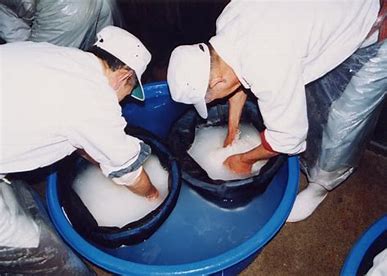
Steaming
If brewing rice (sakamai) is cooked the same as table rice, the brewing rice would be too watery. The purpose of steaming rice is to make it susceptible to enzymes produced by koji mold by heating with steam, which means to make rice more soluble. The goal is to have each grain moist inside and dry on the outside (gaiko nainan). This encourages the Koji mold to dig deep into each grain to reach the moisture at the next process. Steamed rice is classified into koji rice used for koji, and rice for mashing used for fermentation mash. Rice is steamed at about 100 degrees for about 1 hour.

Making Koji
The process of propagating koji mold to steamed rice is called koji production. This is regarded as the most important process for sake production. This supplies diastatic enzyme to steamed rice and nutrients to sake yeast and generate koji derived flavor components. It takes about two days for koji production.
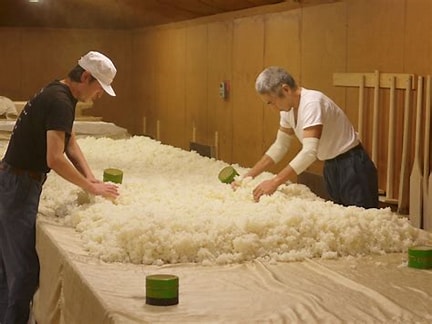
Shubo (Starter culture)
A starter culture refers to a cultivated liquid of steamed rice, koji, and water in a small tank. Starter culture is to cultivate the necessary yeast for alcohol fermentation. Then brewers add yeast to it to grow the yeast needed for fermentation. These days, the Sokujo method is the most common and it takes about 2 weeks to create yeast starter. The quality of this yeast starter influences the flavor and taste of sake a lot.
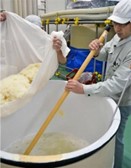
Moromi (Mash) making
Next is preparation of the main mash or “Moromi” which refers to the liquid which steamed rice (rice for mashing), Koji (kakekoji), water, and starter culture are added in a tank for fermentation mash. In a process known as san-dan-jikomi, three ingredients are added over the course of 4 days. This allows the yeast and Koji to adjust nicely between each addition without giving any room for unwanted microorganisms to grow. Mash making takes about four to five weeks.
making.jpg)
Pressing
Once the sake is done brewing, the newly created alcohol needs to be separated from the unfermented rice solids left in the mash. When performing shibori(pressing), the first extracted part is “arabashiri”, the next part is “nakadori (nakagumi or nakadare)”, and the last part is called “seme”. When cloth bags used at pressing stage and suspended, the part extracted by the dripping through the bag is called “furkuroshibori”, “shizuku-zake” and “dobingakoi”. Being squeezed with a rough cloth, the sake is cloudy and is called “nigorizake”. Solids left after pressing stage is called “ori”, and the process of removing ori by precipitation is called “removal of sediment”. Sake which has more ori is called “ori-zake”, and sake which is added an extra ori is called “origarami”. The raw sake at this stage is full strength (usually around 18% alcohol at this point) and unpasteurized.

Filtering
After pressing, any unprocessed matter is removed by filtration. This is often done by using charcoal powder being mixed with the sake. It runs through a chambered filter lined with special filter paper. The purpose of filtration is to decolor, adjust flavor and remove a bad smell and unnecessary microorganisms. Sake without filtration is called “unfiltered” (Muroka). The resulting sake is, after the clear and bright.
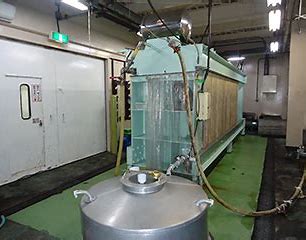
Pasteurization
Once the sake is pressed and filtered, Pasteurization is the next step. This quickly heats the sake to around 65 degrees. The purpose of heat sterilization (heat sterilization at the low temperature) is to inactivate enzymes and to kill hiochi bacteria. There are several methods of Pasteurization. One method is running the sake through a heated pipe. Sake circulates in the pipe until the desired temperature is reached. Another method is to shower or submerge bottles with hot water.
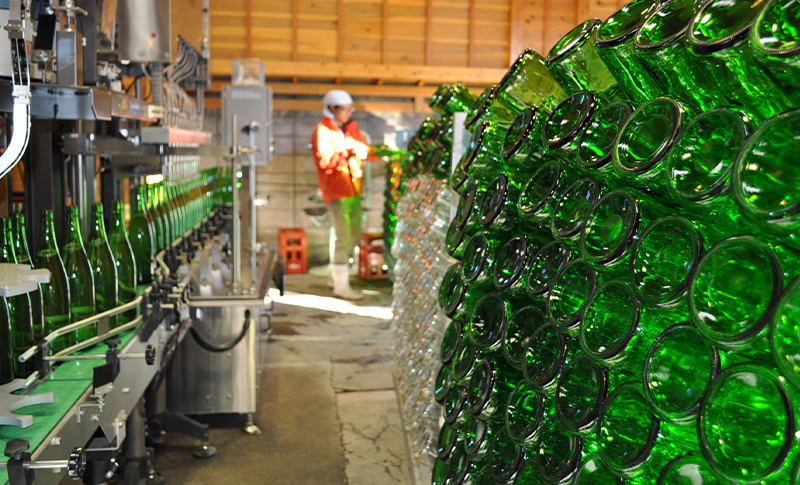
Storage
Most sake are then stored in a tank underground to create smooth sake quality. There are “hiyaoroshi” and “new sake (shiboritate) and aged sake” depending on whether sake is stored or not. There is also so-called “tarusake (cask sake)” made by a certain storage container. At this stage, water might be added to adjust the balance of the alcohol content and flavor. Sake without any additional water is called “genshu”.

Bottling
At last, sake is bottled. Sake is usually pasteurized again and water is added to bring the alcohol content to about 15%. Sake made usning only the first heat sterilization is called ”namazume-shu”, and using only the second heat sterilization is called “namachozo-shu”.

Sake without filtration, heat sterilization and addition of water is called “muroka nama-genshu”, which attract attention as a product with unique flavor characteristics such as “fusion of fruity aroma and ingredients”, “clear taste of sweetness and acidity” and “mellow and smooth”.



